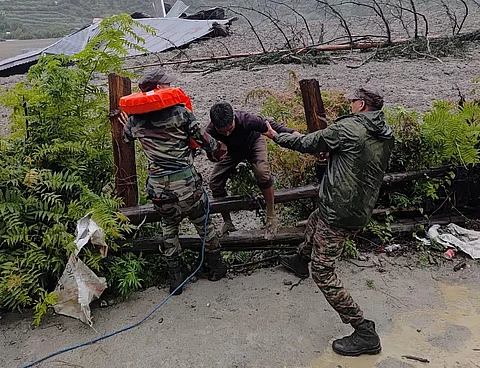

Flash floods in the Kheer Ganga river have devastated Dharali town in Uttarakhand, claiming four lives and leaving many missing.
Prime Minister Modi has expressed his condolences and coordinated with the Chief Minister for relief efforts.
The river overflowed with debris, causing widespread destruction, while rescue operations continue amidst challenging conditions.
Flash flooding in the Kheer Ganga river caused heavy destruction in Dharali town of Uttarkashi district in Uttarakhand on August 5, 2025. So far, four people have been confirmed dead. A large number of people are missing.
Prime Minister Narendra Modi has expressed grief over the incident and spoken to Chief Minister Pushkar Singh Dhami. State and National Disaster Response Force, local police and administration are engaged in relief operations.
At around 1.30 pm on August 5, the Kheer Ganga river flowing through Dharali town overflowed. The river, flowing rapidly with a lot of silt and debris, entered the town and caused havoc. There was a stir after a video clip surfaced, capturing the full magnitude of the disaster.
Uttarkashi District Magistrate Prashant Kumar Arya confirmed four deaths. According to Uttarkashi Disaster Management Officer Karamveer Sharma, relief and rescue operations are still going on and it is not possible to assess the damage at the moment. According to Sharma, Arya has rushed to the spot and at the time of writing this report, he himself was stranded at one place due to the closure of the road.
As soon as the video of the Kheer Ganga wreaking havoc with heavy debris on Dharali surfaced on social media, news reports were rife with talk of a cloudburst. However, speaking to Down To Earth, Rohit Thapliyal, in-charge of the Meteorological Center Dehradun, said excessive rainfall (or cloudburst) has not been recorded in Uttarkashi. Rather, the district has received only light to moderate rains.
But according to Shailendra Godiyal, a journalist who has been reporting in Uttarkashi for nearly a decade and a half, this is not the case. It has been raining heavily for the last two days, he said, and almost all the waterfalls on the hill are overflowing. Not only Kheer Ganga, but the Tel Ganga rivulet near the Army camp in Harsil is also in spate. As is the Awana river in front of Sukki. Godiyal’s words were confirmed by a resident of Dharali village, who now lives in Dehradun. According to him, it has been raining heavily for two days.
Godiyal explained that the Kheer Ganga got its name due to the nature of its flows. Whenever this perennial river is in spate, it always brings heavy debris with it and looks like thick kheer (milk and rice pudding). Every two-three years, the river overflows and its debris wreaks havoc. In 2018 and 2021 too, the river caused a lot of damage in Dharali.
Geologist S P Sati confirmed this. He said 1835 was the year of the worst flood in the river in living memory. Then, the waterbody had inundated the entire town of Dharali. The current settlement has been built on the silt and debris brought along by that flood.
Sati pointed out that people have also encroached on the river’s course and built houses and homestays on it. Godiyal said every year, the local people demand that the district administration build a protective wall on the lines of Kedarnath to protect them from the flood-prone Kheer Ganga. But till now, the administration has not paid any heed.
After 2018, the district disaster management agency conducted an investigation in which it was found that a bugyal (alpine meadow) above Dharali was being destroyed. It is this debris that has probably washed away along with the river, according to Godiyal.
Sati compared the situation to what had happened in 2021 with the Rishiganga river in Reni village.
“Either the debris of an old glacier is stagnant above the village or a mountain is crumbling whose debris has come along with the river,” said Sati.
But can light or moderate rain bring so much debris?
The answer changes with the definition of cloudburst and the location of rainfall. According to the meteorological definition, a cloudburst usually happens when 10 centimetres of rain falls at a location within a span of one hour.
However, Vikram Singh, who was the director of the Meteorological Center Dehradun, once said even a centimetre of rain in the mountains can cause more damage than five centimetres of rain in the plains. The slope and gradient of the river and what comes across in its path determines how much damage it causes.
In such a situation, the question arises whether this catastrophe could have been avoided? Godiyal said the 1835 flood and the debris it dumped on the village is not a part of the village’s collective memory anymore. Moreover, now that they own the land, they see nothing wrong in constructing on it.
However, if the district administration had taken into account the nature of the river and its flow pattern and had taken protective measures like potage walls, the devastation could have been minimised.
Sati disagrees. He said that no one can be saved from such a flash flood. Given that all construction in the village was done on the sediment of the river, the August 5 incident was bound to happen as it would be removed by the river whenever it rose.